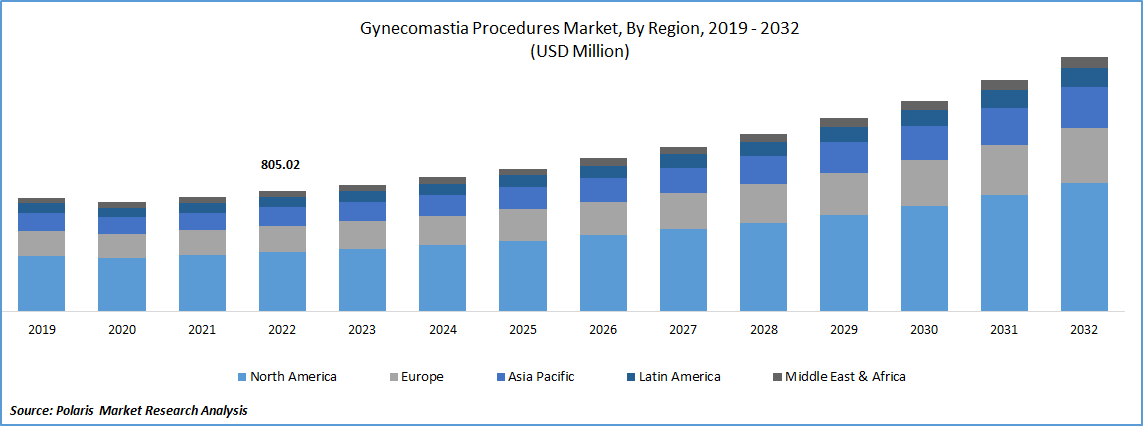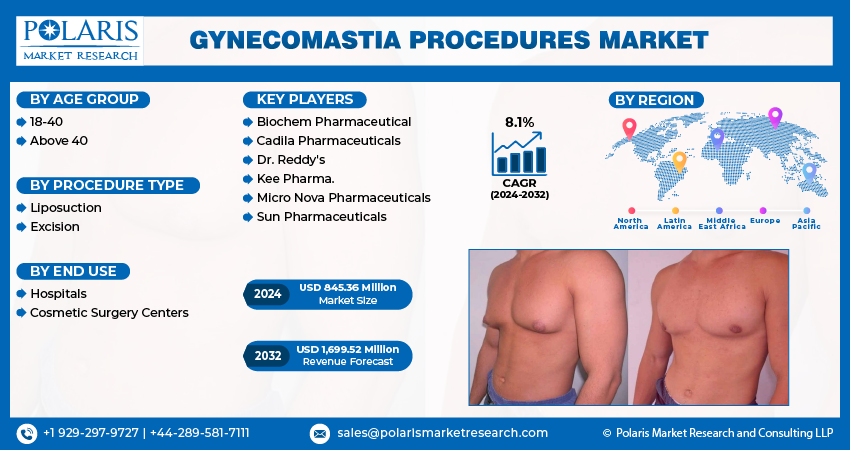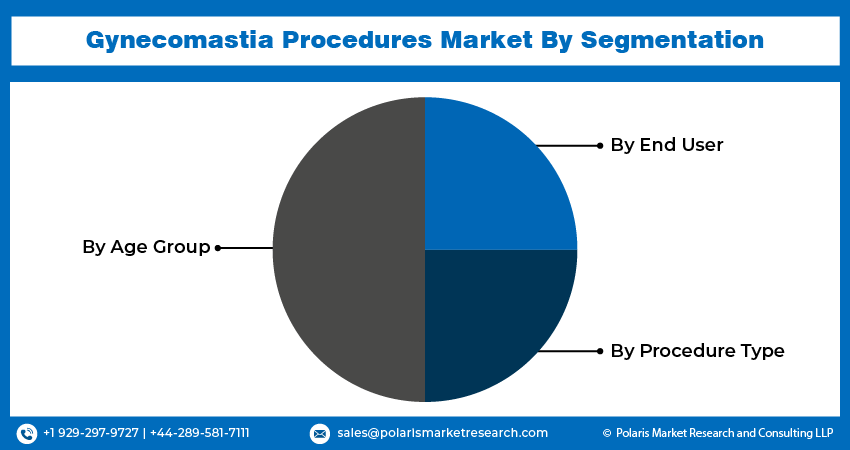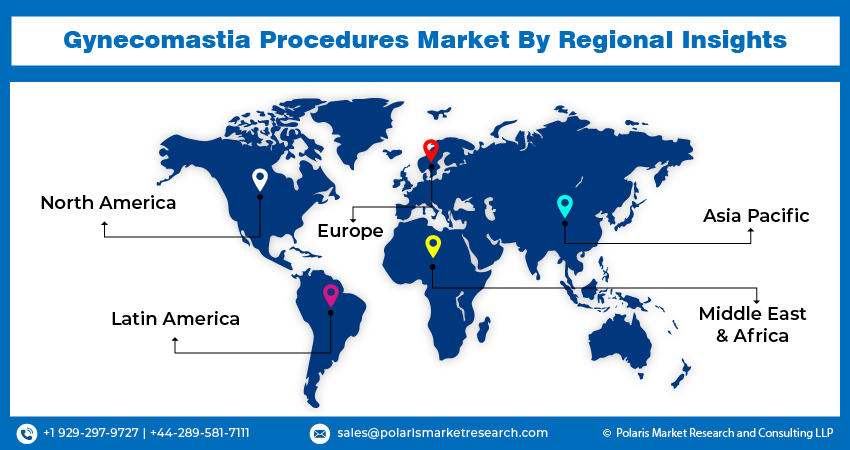
Gynecomastia Procedures Market Share, Size, Trends, Industry Analysis Report, By Age Group (18-40, Above 40), By Procedure Type (Liposuction, Excision), By End-use, By Region, And Segment Forecasts, 2023 - 2032
- Published Date:Oct-2023
- Pages: 118
- Format: PDF
- Report ID: PM3777
- Base Year: 2022
- Historical Data: 2019-2021
Report Outlook
The global gynecomastia procedures market was valued at USD 805.02 million in 2022 and is expected to grow at a CAGR of 8.1% during the forecast period.
In recent years, the incidence of gynecomastia has seen a significant increase, establishing it as a relatively common condition. Research studies indicate that during puberty, approximately 50-60% of adolescent boys experience gynecomastia to some extent, although most cases are mild and typically resolve on their own without requiring treatment. The prevalence of gynecomastia can vary based on the population under study, and it is estimated that around 65% of adult men may encounter gynecomastia at some point in their lives. The likelihood of gynecomastia tends to rise with age, with higher rates observed among elderly males. In India, gynecomastia has become a prevalent concern, with approximately 29,532 gynecomastia procedures performed annually, indicating a significant number of patients seeking treatment for this condition.

To Understand More About this Research: Request a Free Sample Report
Changing lifestyles, characterized by sedentary habits & poor dietary intake, contribute to the increasing prevalence of gynecomastia. Moreover, the growth is bolstered by advancements in treatment options, like liposuction & glandular tissue excision. Liposuction is in high demand due to its impressive success rate of 85% - 95%, making it a reliable and sought-after treatment option for patients. These factors collectively contribute to the growth and expansion of the market for hormonal imbalances and obesity treatment.
However, certain factors act as impediments to market growth, including poor reimbursement policies and low awareness about the gynecomastia procedure. Despite these challenges, the market is expected to witness significant growth due to the increasing importance of self-esteem and physical appearance and the rising number of geriatric individuals seeking body-contouring procedures.
The market for gynecomastia was significantly impacted by the COVID-19 pandemic. During the peak of the pandemic, non-essential surgeries, including gynecomastia procedures, were frequently postponed or canceled, resulting in a temporary decline in surgical interventions. Moreover, patient visits and diagnoses related to gynecomastia experienced a drastic decrease as individuals postponed or canceled routine check-ups, adversely affecting market growth. The pandemic-induced disruptions had a notable effect on the gynecomastia market, leading to a slowdown in surgical activities and patient engagements during that period.

Industry Dynamics
Growth Drivers
The growing correlation between self-esteem and physical appearance is driving the market growth
Market growth is expected to be driven by the growing correlation between self-esteem and physical appearance. A study published in the Journal of Education and Health Promotion in August 2022 revealed a negative association between self-esteem and unhealthy weight in young adults. Additionally, the increasing geriatric population in developed countries is projected to have a positive impact on the market. The American Academy of Dermatology Association reported that cosmetic surgeries in the elderly did not lead to severe complications. Moreover, body-contouring procedures like gynecomastia demonstrated improved outcomes in the elderly compared to the younger age group, attributed to their better lifestyle.
Report Segmentation
The market is primarily segmented based on age group, procedure type, end use, and region.
|
By Age Group |
By Procedure Type |
By End Use |
By Region |
|
|
|
|
To Understand the Scope of this Report: Speak to Analyst
By Procedure type analysis
Excision segment accounted for the largest share in 2022
Excision segment accounted for major global share. Surgical excision proves to be more effective than liposuction when dealing with gynecomastia cases involving the enlargement of the glandular tissue. These innovations have enhanced the efficacy of the procedure, making it a preferred choice for many individuals seeking treatment for gynecomastia with glandular tissue involvement. The availability of refined & precise surgical methods has enabled surgeons to perform removal of the glandular tissue with the minimal scarring. Such advancements have instilled greater confidence in both patients & surgeons, making excision surgery a highly viable and trusted treatment option for gynecomastia cases involving glandular tissue enlargement.
Liposuction segment is likely to register highest growth rate. This is attributed to its less invasive nature compared to excision surgery. It involves small incisions via which cannulas inserted to take out the excess fat. Patients are drawn to the less invasive nature of the liposuction due to the potential for smaller scars, faster recovery times, & reduced post-operative discomfort. These appealing factors have contributed to the increasing popularity of liposuction as a preferred treatment option for gynecomastia.
By End-Use Analysis
Hospitals expected to grow at steady rate during forecast period
Hospitals segment expected to witness robust growth rate. Hospitals offer comprehensive healthcare services, equipped with specialized departments and advanced medical equipment to treat various medical conditions. As gynecomastia gains recognition as a medical concern, hospitals expanded their services to have gynecomastia treatment services, ensuring patients can receive expert care and treatment for this condition in the hospital setting. This trend has contributed to the lucrative growth of the hospital segment in the market for gynecomastia treatment.
Cosmetic surgery centers segment witnessed steady growth. This is primarily attributed to their specialization in a wide range of aesthetic procedures, including body contouring and breast surgery, which encompasses gynecomastia treatment. Surgeons in these centers possess extensive experience and expertise in performing gynecomastia procedures, ensuring superior outcomes and high patient satisfaction rates.
These centers place a strong emphasis on aesthetic results, recognizing the impact of patient's self-confidence & body image. As a result, they are dedicated to delivering more natural and balanced outcomes, which contributes to the growing preference for such centers among individuals seeking gynecomastia treatment. The focus on delivering optimal aesthetic results has bolstered the demand for centers and solidified their position as the leading segment in the market.
In addition, these centers have extensive long-term patient trial data that substantiates the safety of patients undergoing procedures there. According to the American Society of Plastic Surgeons, cosmetic procedures performed outside of hospitals have demonstrated a complication rate of less than 1%. This data reinforces the safety and reliability of treatments offered in cosmetic surgery centers. For instance, as reported by the National Institute of Health, in 2020, 82% of cosmetic procedures in the U.S. were conducted in outpatient surgical centers, indicating the increasing popularity of such advanced clinics for aesthetic procedures.
By Age group analysis
18-40 age group expected to grow at steady rate during forecast period
18-40 age group segment expected to witness robust growth rate. At this group represents life span when puberty occurs, it experiences a higher prevalence of the gynecomastia cases. Furthermore, increased societal awareness of gynecomastia may contribute to this age group's higher likelihood of seeking medical intervention for their concerns. As individuals within the 18-40 age range become more informed about gynecomastia and its available treatments, they are more inclined to pursue medical solutions, thereby driving their higher representation in the market.

Regional Insights
North America region dominated the global market in 2022
North America region dominated the global market. Region is characterized by intense competition, with numerous specialized clinics, hospitals, and healthcare providers offering a wide array of treatment options for gynecomastia. This competitive landscape fosters innovation and ensures a high standard of care, further strengthening the region's dominance in the market. As a result, it continues to lead in terms of market share, driven by its advanced healthcare ecosystem, patient-centric regulations, and a competitive environment that fosters continuous improvement in gynecomastia treatments.
APAC is likely to emerge as fastest growing region. The rising awareness about gynecomastia and available treatment options is leading to a reduction in the stigma associated with the condition in this region. Consequently, there is a growing acceptance of gynecomastia treatments, driving an increased demand for such procedures. Region has witnessed substantial economic growth, leading to a rise in disposable income among the population. This economic development is further contributing to the growth of the market in the region, as individuals have more financial means to pursue gynecomastia treatments.

Key Market Players & Competitive Insights
The gynecomastia procedures market is fragmented and is anticipated to witness competition due to several players' presence. Major service providers in the market are constantly upgrading their technologies to stay ahead of the competition and to ensure efficiency, integrity, and safety. These players focus on partnership, product upgrades, and collaboration to gain a competitive edge over their peers and capture a significant market share.
Some of the major players operating in the global market include:
- Biochem Pharmaceutical
- Cadila Pharmaceuticals
- Dr. Reddy's
- Kee Pharma.
- Micro Nova Pharmaceuticals
- Sun Pharmaceuticals
Recent Developments
- In March 2023, Cadila Pharma has unveiled plans to expand its current facility in Gujarat with a substantial investment of Rs 1,000 crore.
Gynecomastia Procedures Market Report Scope
|
Report Attributes |
Details |
|
Market size value in 2023 |
USD 845.36 Million |
|
Revenue forecast in 2032 |
USD 1,699.52 Million |
|
CAGR |
8.1% from 2023 – 2032 |
|
Base year |
2022 |
|
Historical data |
2019 – 2021 |
|
Forecast period |
2023 – 2032 |
|
Quantitative units |
Revenue in USD million and CAGR from 2023 to 2032 |
|
Segments covered |
By Product, By Seasoning, End Use, By Distribution Channel By Region |
|
Regional scope |
North America, Europe, Asia Pacific, Latin America; Middle East & Africa |
|
Key companies |
Cadila Pharmaceuticals, Sun Pharmaceuticals, Biochem Pharmaceutical, Dr. Reddy's, Micro Nova Pharmaceuticals, and Kee Pharma. |
FAQ's
The global gynecomastia procedures market size is expected to reach USD 1,699.52 Million by 2032.
Key players in the gynecomastia procedures market are Cadila Pharmaceuticals, Sun Pharmaceuticals, Biochem Pharmaceutical
North America contribute notably towards the global gynecomastia procedures market.
The global gynecomastia procedures market is expected to grow at a CAGR of 8.1% during the forecast period.
The gynecomastia procedures market report covering key segments are age group, procedure type, end use, and region.
